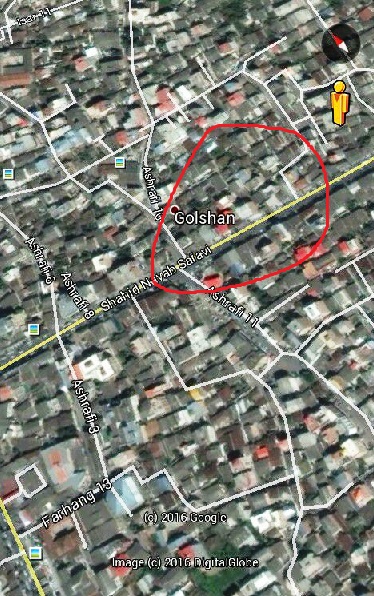
An aerial view of the old Jewish quarter in Babol.
Babol is the capital of the Mazandaran province in Iran and is located 15 kilometers south of the Caspian Sea. It is one of the most populous cities in the province.
Origin of Babol
Historical texts suggest that Babol was established after the advent of Islam in Iran, though some historians believe an earlier city named Mehmitra existed at the same location in the pre-Islamic era. Following the Islamic conquest, the name of the city was renamed to Barforush Village, then to Barforush as it expanded, and finally to Babol by Reza Shah on 1932. Reza Shah’s order was announced on 21 March 1932, which is equivalent to the first day of the Iranian year.
Babol gained prominence during the Safavid era under Shah Abbas, who renamed the city from Barforush Village to Barforush and built a palace for himself on Bahre eram Island in Babol. The city’s commercial importance grew, making it the provincial capital during the Afsharid and Zand periods.
Pre-Islamic Babol
A group of historians believe that before the advent of Islam in Iran, there was a city called “Mehmitra” located where Babol is today. The inhabitants of Mehmitra practiced Zoroastrianism, and the city was home to a large and important fire temple.
As recorded in the notes of Ardeshir Barzegar:
“In the past, the city of Babol was a symbol of a pure and holy city near the sea (i.e., Caspian Sea) and because of the presence of the “Great Mitra” (fire temple of Mitra), its inhabitants called it “Mehmitra” or the place of the Great Mitra. This name was converted to “Mehmtira” in Arabic during the Islamic period. “Mamtira” or “Mamatir” is the Arabicized form of the Persian “Mehmitra” and is derived from “Meh” meaning great and “Mitra” meaning friendship, kindness, truthfulness, and righteousness.”
Jewish Presence in Babol
Jewish immigration from Isfahan
According to the notes of Professor Amnon Netzer, the presence of Jews in the northern regions of Iran, especially in the city of Barforush (present-day Babol), dates back to the Safavid period, when anti-Semitism was widespread in the city of Isfahan, which was known as Yahudiah, or Jewish Place at the time. Many Jewish citizens decided to leave Isfahan before facing more serious threats and moved to other parts of Iran that were more secure.
Jewish contribution to Iran’s economy
It is said that by the order of Shah Abbas, more than seventy Jewish households migrated from Isfahan to Barforush in order to revitalize business and optimize the economic situation of the city.
Throughout history, the rulers of Iran have consistently recognized and valued the contributions and innovations of the Jewish community in their country. They have relied on the Jews to help develop and improve the economic situation and have called upon them in times of need.
The Qajar Era
According to research, the number of Jewish citizens in Babol during the Qajar era was estimated to be around 700 individuals. Bitter events forced some Jews to convert to Islam and others to leave the city.
The Jews of Barforush were originally immigrants from Isfahan who were settled in Mazandaran by order of Shah Abbas Safavid. Later, Jewish families from Bukhara also migrated to Barforush and became involved in trade. Notable among these families were the Tabari and Papi families.
Naser al-Din Shah Qajar
During the reign of Naser al-Din Shah Qajar, many travelers, political agents, and military personnel traveled to Barforush. In their reports on the Jews, they estimated their population to be between 50 and 70 households living in the “Johud Mahaleh” (Jewish Quarter). They also mentioned that the Jews of the city had two synagogues, a school, and a private cemetery.
Most of the Jews were engaged in peddling or buying and selling agricultural products. However, later they also turned to businesses such as drapery, jewelry, liquor sales, and medicine sales. Through their economic activities, they greatly contributed to the flourishment of Barforush’s economy. They also achieved remarkable successes in foreign trade with the northern neighboring country, Russia.
Establishment of Israel
After World War II and the establishment of the State of Israel in 1948, a surge in anti-Semitic sentiments led many Jews worldwide to migrate to the Holy Land. This migration included a group of Jews from the city of Babol. As a result, fewer than 50 households remained in the “Johud Mahaleh” (Jewish Quarter), now known as the Shamshirgar neighborhood.
1979 revolution of Iran
After the Islamic Revolution in Iran in 1979, Babol’s Jewish population gradually decreased. Some members of the community moved to Tehran, while others emigrated from Iran altogether. Today, Babol has no Jewish inhabitants, and aside from an abandoned cemetery, no traces of the Jewish community remain.

Former Jewish neighborhood in Babol, known as Johud Mahaleh (Jewish Quarter), Spring 2016.

Former Jewish neighborhood in Babol, known as Johud Mahaleh (Jewish Quarter), Spring 2016.

Former Jewish neighborhood in Babol, known as Johud Mahaleh (Jewish Quarter), Spring 2016.

Former Jewish neighborhood in Babol, known as Johud Mahaleh (Jewish Quarter), Spring 2016.

A gravestone for Yosef Ben Asher in Babol, death 5699 Hebrew Calendar, equivalent to 1939

A Jewish gravestone in Babol for Mollah Elisha, death 5698 Hebrew, 16 October 1938.


 فارسی
فارسی